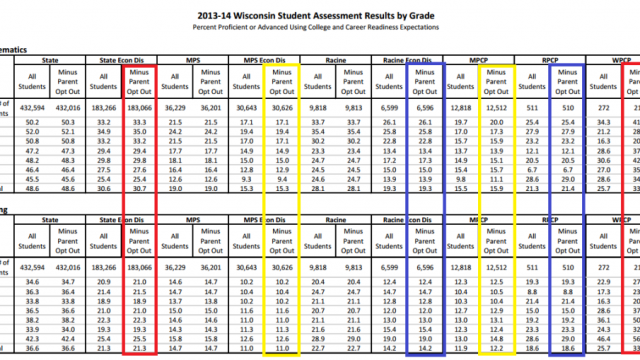How Wisconsin’s voucher students did better than you were told

By Ryan Ekvall | Wisconsin Reporter
MADISON, Wis. — Voucher students outperformed their public school counterparts on Wisconsin standardized tests, but you wouldn’t know it by reading any of the major state newspapers.
Newly released statistics from the Department of Public Instruction show that voucher students scored better than public school students, nearly across the board, when controlling for the students’ economic status. But don’t take our word for it. Here’s the data:
TEST SCORES: Here are the standardized test scores for public school and voucher school students, grouped by student poverty levels.
Standardized test scores tend to correlate with income level. Students living in poverty tend to score lower on standardized tests than students in better economic situations.
When attempting to control student test scores for these factors, voucher students mostly outperform public school students on the tests. They have also improved test scores at a faster rate during the past four years.
That said, DPI’s data doesn’t allow for exact comparisons of student performance across poverty levels. The DPI reports voucher student numbers without breaking down the data according to economic status. For public school students, DPI provides the scores for the students receiving free or reduced lunches.
The voucher program income cutoffs don’t perfectly align with free or reduced lunch income cutoffs, one measurement of student poverty.
A family of four cannot earn more than $43,752 to qualify for a reduced-price lunch.
The income cutoff for the statewide school-choice program is $50,636 for a family of four. In 2011 the Legislature increased the income limits for the Milwaukee and Racine programs from nearly $40,000 a year to nearly $71,000 per family of four.
The vast majority of students in the school choice-program qualify for a free or reduced lunch.
Media misleads
The major news outlets throughout the state, however, reported that voucher students in private schools performed worse than public school students on standardized tests.
“DPI: Wisconsin voucher schools show lower test scores compared to public schools” was the Wisconsin State Journal headline.
“Voucher students post gain in math, reading; still lag public schools,” read the Milwaukee Journal Sentinel.
“Voucher student scores lag public school students,” read the Racine Journal Times, which ran the Associated Press story.
That’s what they reported, more or less following the narrative in the state Department of Public Instruction’s news release regarding the testing data.
It’s technically all correct, but only when comparing apples to oranges. In this case, that means comparing test scores of poorer voucher students with those of wealthier public school students.
Many of the newspaper reporters also included the students who opted out of the tests as part of the voucher students’ overall score. DPI reports students who opt-out of tests as scoring non-proficient.
The DPI numbers and media accounts also fail to adjust for the thousands of new voucher students who attended their private school for just a few months before taking the tests. Most of these students’ academic careers have been in the public school system.
“DPI advocates and lobbies against the program and consistently manipulates the release of data to put the school choice program in a negative light,” said Jim Bender, president of School Choice Wisconsin. “This release of data is no different. Unfortunately, many in the media just fall for it.”
APPLES-TO-APPLES: School Choice Wisconsin rearranged the testing data provided by DPI to give an apples-to-apples testing comparison.
It’s a hard fall.
Researchers looking at the decades-long Milwaukee Parental Choice Program found that voucher students had better reading and math scores, graduated high school at a higher rate and did better in college than their MPS counterparts. The choice program also helped MPS scores increase by fostering competition for students and, therefore, tax dollars.
Contact Ryan Ekvall at rekvall@watchdog.org , 608-257-1382 or follow him on Twitter @Nockian.







